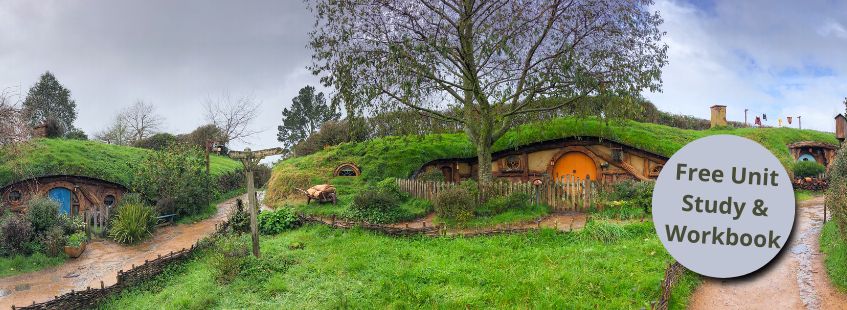We all know there have been amazing works of literature that have been written and enjoyed by millions throughout the years. These stories and authors have originated worldwide and helped expand our viewpoints and the way we see the world. While some classics elders force upon us, they are classics for a reason and sometimes become some of our most well-loved books. This unit study is on J.R.R. Tolkien’s novel, The Hobbit, and is best suited for grades 7-12. Many people the world over love this classic of British literature. Hopefully, your student will fall in love with it as well.
The Hobbit Background
J.R.R. Tolkien wrote and published The Hobbit in September 1937. The world had barely recovered from World War I and was on the cusp of World War 2. On the brink of chaos, 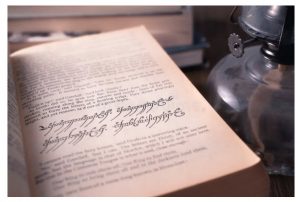 Tolkien gave the world an epic adventure that begins: “In a hole in the ground there lived a hobbit.”
Tolkien gave the world an epic adventure that begins: “In a hole in the ground there lived a hobbit.”
John Ronald Reuel Tolkien was born in 1892 in Bloemfontein, South Africa. Upon the death of his father in 1896, Tolkien returned to England with his mother and younger brother. After his mother passed away in 1904, he immersed himself in both modern and ancient language studies. World War I broke out in 1914, and after marrying his love, Edith Bratt, in March of 1916, Tolkien enlisted and was sent to France. In less than a year, he became ill with “trench fever,” spent time in the hospital, and returned to England.
Throughout these years, Tolkien continued with his language studies and had already begun work on writing his own languages and stories. The war ended, and after a few short-lived teaching posts, Tolkien took a job at the University of Oxford as the Professor of Anglo-Saxon. He continued at Oxford, changed his position to the Merton Professorship of English Language and Literature in 1945, and maintained that position until he retired in 1959.
Tolkien and Edith had 4 children: sons John Francis, Michael Hilary, Christopher John, and daughter Priscilla Anne. He loved telling his children stories, and they often were the first ones to hear his tales that are now so loved by the world.
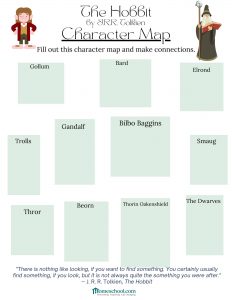
Tolkien’s inspiration for The Hobbit was the ancient languages and cultures he studied, specifically Anglo-Saxon and Scandinavian, with a mix of the rural middle-class English culture of the day. Imagine that a typical 1930s Englishman who loves the comforts of home drops into a medieval setting and becomes the tale’s hero.
Tolkien was once quoted as saying, “I am in fact a Hobbit (in all but size). I like gardens, trees and unmechanized farmlands; I smoke a pipe, and like good plain food (unrefrigerated), but detest French cooking; I like, and even dare to wear in these dull days, ornamental waistcoats. I am fond of mushrooms (out of a field); have a very simple sense of humour (which even my appreciative critics find tiresome); I go to bed late and get up late (when possible). I do not travel much.” It’s easy to see how and why The Hobbit is so loved by so many of all ages.
More About The Hobbit
While this unit study is written for middle and high school students, The Hobbit is loved by many ages. Children as young as 8 can enjoy it with parents as a read-aloud and the book can be read alone by ages 11 and up (7th grade reading level). Many who have read Tolkien’s The Lord of the Rings trilogy have found it more arduous as it is rated for grades 9-12 and above, and the Old English dialect can be more difficult to understand.
J.R.R. Tolkien wrote more than an incredible fantasy. There are many lessons to be learned from and woven throughout The Hobbit. Without giving too much away before you get a chance to complete the study, be on the lookout for these overarching themes, which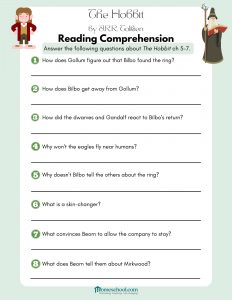 characters portray them, and how you can incorporate them (or not) into your own life:
characters portray them, and how you can incorporate them (or not) into your own life:
- Bravery
- Courage (different than Bravery)
- Risk-taking
- Idolatry
- Perseverance
- Humility
- Strength
- Joy
- Friendship
- Dedication
There are so many more, but hopefully, this small list will aid you as you dive into the book!
Make a Hobbit-Themed Meal
Did you know that many consider September 22 as Hobbit Day? This date marks the birthday of Bilbo Baggins which they celebrate in The Lord of the Rings: The Fellowship of the Ring with Bilbo’s 111th birthday party. One also quickly learns by reading The Hobbit that hobbits love to eat! Whenever you may choose to celebrate, here are a few suggestions for additions to a Hobbit-themed meal.
- Create a Hobbit charcuterie board: Begin by making a cheese ball in the shape of a hill. Once you have your “hobbit-hole,” dye some cream cheese green, and using a piping bag and frosting tip, cover the hill in grass. A circular piece of gouda or provolone will work great for the door. Once you have the main pieces finished, now comes the fun part! Use different meats and cheeses to add all the cobblestone and stepping stone details. Using some yellow-dyed cream cheese, add the knob and Gandalf’s mystery mark to the door. Make sure you take a few breaks to refrigerate as
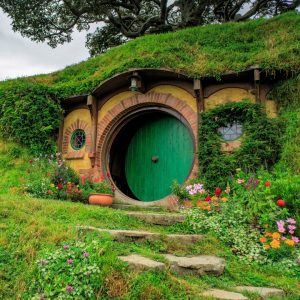 you’re putting it together to make sure the cheese doesn’t melt or fall apart. For some visual inspiration and a few more details, visit this site and see her “Shire-cuterie” board!
you’re putting it together to make sure the cheese doesn’t melt or fall apart. For some visual inspiration and a few more details, visit this site and see her “Shire-cuterie” board! - Make a Hobbit-Style Mushroom Toast: To make this very hobbit-sounding dish, begin by sauteeing fresh mushrooms in an olive oil-coated skillet. Then add 1/8 c. cooking sherry to de-glaze the pan. Once the sherry is almost completely reduced, add a tablespoon of butter and a sprig of thyme. Finally, remove the thyme and serve on toast. These mushrooms are also great on chicken, beef, or even as a side dish.
- Bake a Batch of Beorn’s Honey Cakes: First, preheat the oven to 350 degrees and prepare a muffin tin by coating each muffin spot heavily with butter and set it aside. Next, in a medium bowl, whisk together 1 3/4 c. flour, 1 1/2 tsp baking powder, 1/2 tsp salt, 1/4 tsp fresh ground nutmeg, and the zest of one lemon. Then, using a fork, add one stick of unsalted, room-temperature butter until the mixture looks like sand. In a small bowl, whisk together 3/4 cup milk, 2 eggs, 1 tsp vanilla, and 3/4 cup high-quality honey. Pour the liquids over the dry mixture until just combined without over-mixing. Lastly, spoon the batter evenly into the muffin tin and bake until they are mostly done, about 16 minutes.
Carefully remove the muffins from the tin and place them on a lined baking sheet. Warm 1/4 cup of honey in the microwave for 10 seconds. Then use a silicone brush to brush the honey onto the muffins. Let them sit for about 5 minutes so the honey can soak in. Then place the baking sheet back into the oven for an additional 8-10 minutes until the muffins are golden brown. Finally, cool and enjoy!
- However, if you are more ambitious and want to create an entire menu for a Hobbit party, here is a sample menu. Visit this blog for the complete recipes.
- Breakfast: Scones and Jam
- Second Breakfast: Grilled Strawberry Shortcake with Lemon Cream
- Elevenses: Lembas Bread
- Luncheon: Fish and Chips
- Afternoon Tea: Honey Cakes
- Dinner/Supper: Pork Pies
The Hobbit Learning Videos
Watch clips from interviews with Tolkien himself!
A documentary on J.R.R. Tolkien
Listen to the classic BBC Radio version of The Hobbit!
